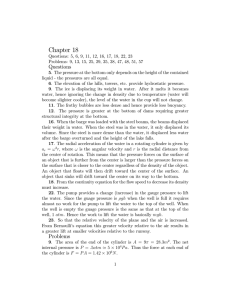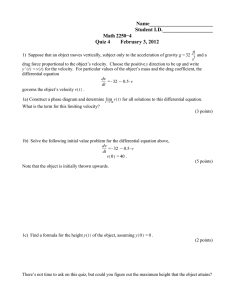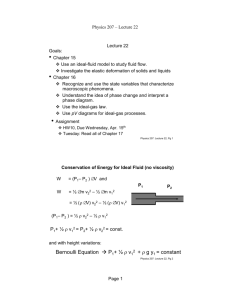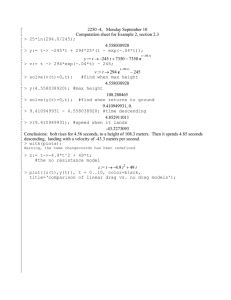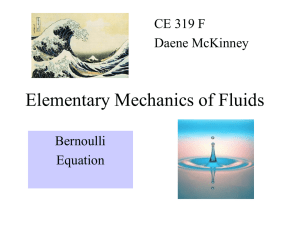Lecture 5 • Preliminary Version Contents
advertisement
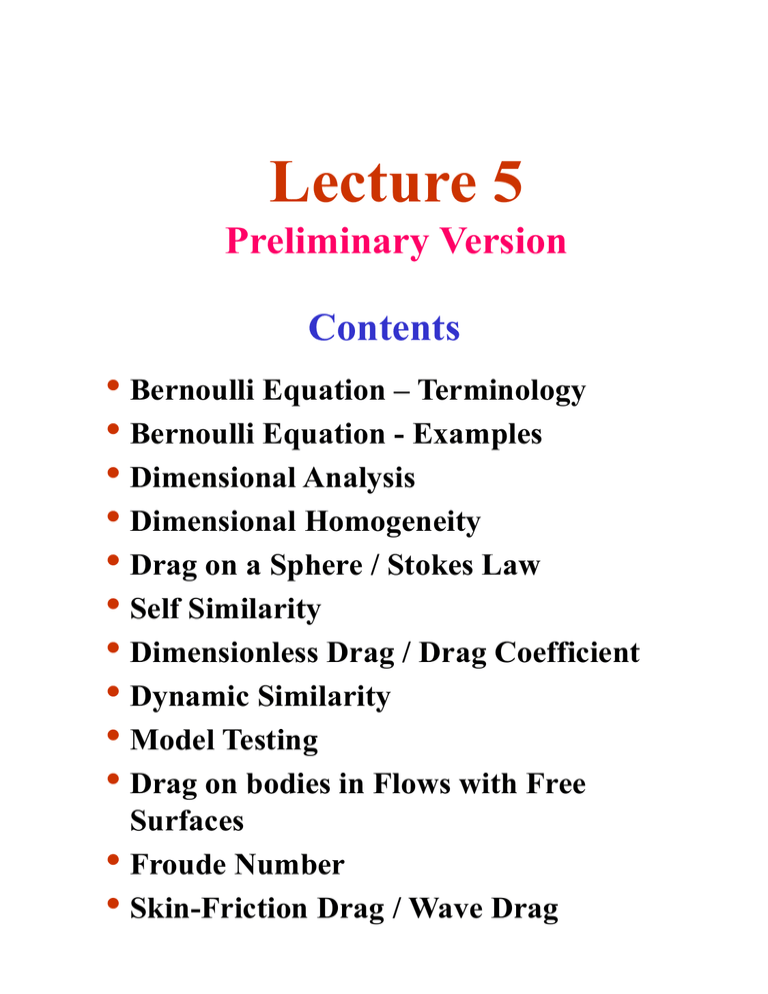
Lecture 5 Preliminary Version Contents • Bernoulli Equation – Terminology • Bernoulli Equation - Examples • Dimensional Analysis • Dimensional Homogeneity • Drag on a Sphere / Stokes Law • Self Similarity • Dimensionless Drag / Drag Coefficient • Dynamic Similarity • Model Testing • Drag on bodies in Flows with Free Surfaces • Froude Number • Skin-Friction Drag / Wave Drag What Did We Do In Last Lecture? Derivation of Bernoulli Equation p 2 v 2 g z const. • Constant along streamline • All terms have units of pressure • p is the physically existing pressure • 2nd term is kinetic energy per unit volume associated with mean motion of flow • 3rd term hydrostatic pressure What Did We Do In Last Lecture? Keep in mind analogy … Epot + Ekin = const. Finished previous lecture with … BERNOULLI EQUATION p v2 z const . H g 2g Alternative Form p 2 v 2 g z const . (7) • Equations apply along a single stream line. • Constant for each streamline can be different. Continued... • Eq. (7) from previous lecture / slide … p • 2 v 2 g z const. (7) If Eq. (7) integrated along streamline between any two points indicated by suffixes 1 and 2 one gets ... p1 2 v12 g z1 p2 2 v22 g z2 This is form in which we will usually apply Bernoulli Equation most of the time. Continued... • Note: For compressible fluid integration of Euler’s equation ... 1 dp dv dz v g 0 ds ds ds can only be partially completed to give ... dp v 2 g 2 g z 0 Now need relation between density and pressure to continue. Terminology for Bernoulli Equation p (1) 2 v2 (2) gz (3) const . (4) (STATIC) PRESSURE (1) = The physically existing pressure in fluid. Whenever reference is made to “pressure” without further qualification then interpret as this one. DYNAMIC PRESSURE (2) = Not a physically existing pressure. If z=0, such that Elev. Press. Vanishes, then Dyn. Press. is the difference between Tot. Press. And Stat. Press. ELEVATION PRESSURE (3) = Can often be made to vanish, i.e. when streamline horizontal such that we can chose z=0. If streamline not horizontal, but if change in height is small such that Elev. Press. is small compared to other terms one usually neglects it. TOTAL PRESSURE (4) = This has physical significance that it is the pressure at which fluid comes to rest. Assume z=0, V=0 then one gets Stat. Press=Tot. Press. Terminology for Bernoulli Equation p • 2 v2 gz const . Note that the STATIC PRESSURE is NOT the pressure in a static fluid (that is called the hydrostatic pressure). • Neither is the STATIC PRESSURE the pressure where the fluid is at rest (that is called the stagnation pressure). Terminology for Bernoulli Equation • For ... p1 2 v12 g z1 p2 2 v22 g z2 v2 0 and z1 z2 With: p1 • 2 v12 p2 Hence sum of static pressure at station 1 plus dynamic pressure at station 1 is equal to static pressure at station 2 where fluid is at rest (stagnates). Thus we call ... p1 2 v12 Stagnation Pressure (or Pitot Pressure) Final Terminology • When Bernoulli written in form ... p g (1) v2 2g (2) z const. (3) (4) … such that all terms in units of ‘LENGTH’ then one calls ... (1) = STATIC HEAD (2) = DYNAMIC HEAD (3) = ELEVATION HEAD (4) = TOTAL HEAD … and finally ... (1) + (2) = STAGNATION HEAD And recall that ... Pressure measured relative to atmospheric pressure is called ... GAUGE PRESSURE or GAGE PRESSURE … as distinct from ABSOLUTE PRESSURE Example 1: Pitot-Static Tube / Prandtl Tube Continued … (1) ( 2) p1 p2 v1 ? v2 0 Question: What is value of v1? Solution: • Bernoulli for points (1) and (2) p1 • 2 v12 g z1 p2 2 v22 g z2 Neglect hydrostatic pressure; horizontal streamline … p1 2 v12 g z1 p2 p1 2 v12 p2 2 2 v22 g z2 v22 Continued … • (1) ( 2) p1 p2 v1 ? v2 0 Point (2) is stagnation point where velocity is zero … p1 2 v12 p2 p1 • 2 2 v22 v12 p2 Solve for velocity … v1 2 p2 p1 Continued … (1) ( 2) p1 p2 v1 ? v2 0 Stagnation Pressure • Free-Stream Static Pressure. Solve for velocity … v1 2 p2 p1 [Pressure here Equal to p1 at point (1) since it is assumed that probe does not affect flow.] Continued … Pitot-Static Tube / Prandtl Tube • This type of probe/methodology is used in my Vortex / • Wind tunnel Lab L5 to measure free stream velocity via pressures! In lab I will assume that you are familiar with this! • In lab will work with arrangement similar to that shown below. The difference being that aeroplane is replaced by a circular cylinder, and probe not in wake of cylinder but in region where flow is not affected by presence of cylinder. Pitot-Static / Prandtl Tube Example 2: • Water flowing in open channel at depth of 2m and velocity 3m/s. It then flows downs contracting chute into another channel where depth is 1m and velocity 10m/s. Assuming frictionless flow, determine difference in elevation of the channels. (1) 2m 3m/s y? 1m ( 2) 10m/s Solution: • Bernoulli for points (1) and (2) p1 • 2 v12 g z1 p2 2 v22 g z2 (A) Since (1) and (2) on free surface: p1 p2 patm. Eq. (A) becomes... 2 v12 g z1 2 v22 g z2 (B) Continued ... (1) 2m 3m/s y? 1m • 2 v12 g z1 2 v22 g z2 • From sketch we see... z1 y 2 m • Introduce this into (B) ... 2 v12 g y 2 2 (B) v22 g z2 (C) Solve (C) for y ... y • 10m/s Last line from previous page repeated... • ( 2) 1 2 2 v2 v1 z2 2 m 2g (D) With given values ... v1 3 m/s , v2 10 m/s , z1 1 m Continued... • Eq. (D) yields... y 2 2 10 m/s 3 m/s 1 m 2 m 2 2 9.81 m/s 1 3.64 m Example 3: VENTURI TUBE Example 3: VENTURI TUBE • Venturi tube is device where flow rate in a pipe line is measured by narrowing a part of tube. In narrowed part flow velocity increases. By measuring resultant decreasing pressure flow rate in pipe line can be determined. m (with ) m w (3) D2 with Area, A2 (2) w Water z2 z1 (1) D1 with Area, A1 z0 Solution: • Bernoulli for points (1) and (2) p1 • w 2 V12 w g z1 p2 w 2 V22 w g z2 (1) Mass conservation yields... A1 V1 A2 V2 A1 V2 V1 A2 (2) Continued ... • Substituting Eq. (2) into Eq. (1) gives... w w A1 2 V1 w g z2 p1 v12 w g z1 p2 2 2 A2 • Rearrange ... A 2 V12 1 1 p1 p2 w g z1 z2 A2 2 w V1 p1 p2 w g z1 z2 2 w A1 1 2 A2 This solution is maximum velocity V1 which would exist for frictionless flow. In reality there is viscosity present and one introduces a discharge coefficient cd such that ... V1 actual cd V1 ideal • To apply above equation still need to evaluate pressure difference ... Continued ... • How to get pressure difference …. h m h l Water, w z2 z1 (2) (1) • Use pressure-depth ideas developed earlier. Summing up all pressure contributions on path from (1) to (2) ... p1 w g z2 z1 w gl w gh m gh m gh m gh w gl p2 p1 p2 w g z2 z1 w gh m gh p1 p2 w g z2 z1 w m gh Example 4: • Beavers with engineering degrees discovered use of Bernoulli principle to ventilate burrows. If mount is built at one entrance wind velocity increases, creating a pressure differential that induces air flow through burrow. Calculate the pressure difference between entrance and exit for the friendly beaver... V 22 km/h Streamline ( 2) V 18 km/h (1) p2 p1 air 1.225 kg/m3 Solution: • Bernoulli for points (1) and (2) p1 • 2 v12 g z1 p2 2 v22 g z2 (A) Assume negligible elevation change, hence: z1 z2 p1 • 2 Eq. (A) becomes... v12 p2 2 v22 Solve (B) for pressure difference ... (B) Continued... • Last equation from previous slide repeated... p1 2 v1 p2 v22 2 2 p p1 p2 • (C) With given values... v1 18 km/h 5 m/s • v22 v12 2 v2 22 km/h 6.11 m/s Eq. (C) yields ... 1.225 kg/m 3 6.11 m/s2 5 m/s2 p p1 p2 2 kg m 2 N s 7.55 7.55 7.55 7.55 Pa 2 2 2 ms m m kg Example 5: Homework/ Background Reading • A hurricane is a tropical storm formed over ocean by low atmospheric pressures. As hurricane approaches land, inordinate ocean swells (very high tides) accompany hurricane. A Class-5 hurricane features winds in excess of 240 km/h, although wind velocity at center “eye” is very low. In sketch below atmospheric pressure 310 km from eye is 101,591 Pa (558.8 mm Hg at point 1, generally normal for ocean) and winds are calm. Hurricane atmospheric pressure at eye at point (3) is 74,500 Pa (762 mm Hg). (I) Estimate ocean swell at eye of the hurricane at (3) (II)Estimate ocean swell at (2) where wind velocity is 310 km/h. Eye Hurricane Calm Ocean (1) Level (2) h2 (3) h1 Ocean Continued ... Assumptions • Steady, incompressible, irrotational (so that Bernoulli applicable) (Note: This is certainly a very questionable assumption for a highly turbulent flow) • The effect of water drifted into air is negligible Properties Density air A 1.225 kg/m Density sea water 3 SW 1023 kg/m 3 Density Mercury M 13,560 kg/m 3 Continued, Cengel p. 199 ... Solution, Part (I): • Reduced atmospheric pressure over the water causes to rise. Thus decreased pressure at (3) relative to (1) causes ocean water to rise at (3). Hence... p ghHg ghSW Hg ghHg SW ghSW hSW hSW 13,560 kg/m 3 1023 kg/m 3 Hg hHg SW (A) 762 mm Hg 558.8 mm Hg 2.693 m • This result is equivalent to the storm surge at the eye of the hurricane since the velocity there is negligible and there are no dynamic effects. Continued... Solution Part (II): • Here we have to take the high wind speed into account and need Bernoulli. We write down Bernoulli equation for points A and B... p A v A2 pB vB2 zA zB g 2 g g 2 g • Since zA=zB and vB=0 we have... p A v A2 p B g 2 g g 2 240,000 m/s pB p A v 2A 3600 226 .5 m g 2g 2 9.81 ms -2 • Density value to be used is air density in hurricane... Hur PAir Patm, Air atm, Air 74,500 Pa 1.225 kgm 3 101,591Pa 0.898 kgm 3 Continued... • Using relation (A) from Part (I) we get ... Air hdynamic h SW Air hSW 0.898 kg/m 3 1023 kg/m 3 226.5 m 0.2 m • Therefore pressure at (2) is 0.2m seawater column lower than pressure at point (3) due to high wind velocities, causing ocean to rise an additional 0.2 m. Then total storm surge at point (2) becomes... h2 h1 h dynamic 2.693 m 0.2 m 2.893 m DISCUSSION Problem involves highly turbulent flow and intense breakdown of streamlines. Thus, applicability of Bernoulli equation in Part (II) is questionable. Furthermore, flow in eye of storm is not irrotational, and Bernoulli constant changes across streamlines. Bernoulli analysis can be thought of as limiting, ideal case, and shows that rise of seawater due to highvelocity winds cannot be more than 2.893m. Dimensional Analaysis and Model Testing •Introduction to Dimensional Analysis Consider drag D of sphere …. On what quantities does it depend? Diameter, d Flow Speed, V Fluid Density, Fluid Viscosity, Write D F d ,V , , (1) • Note: Eq.(1) reads … Drag, D, is a Function of ... What does the above mean in terms of the measurements we have to carry out to collect data for all possible spheres in all types of fluids? Continued ... WE NEED ... d increases from curve to curve 1 page for Drag as function of 2 variables (e.g. velocity and diameter) 1 page for each value of 1 book for Drag as function of 2 variables (e.g. velocity, diameter, density) Shelf of books for Drag as a function of 4 variables (velocity, diameter, density, viscosity) If we want 10 data points per curve, at £10 each experiment, this will cost... 10 10 10 10 £10 £100,000 THERE MUST BE A BETTER WAY !?!? Continued... DRAG GOAL IS TO COMPRESS SHELF OF BOOKS INTO ONE SINGLE GRAPH... 4 Independent Experimental Parameters How Could We Possibly Achieve This? •Dimensional Analysis for Re<<1 (Note: Later we will relax this restriction and look at larger Re.) What does imposed restriction mean? Re 1 Rate of Change of Momentum Inertia Force i.e. 1 Viscous Force Viscous Force Inertia Forces Viscous Forces Viscous Forces are the dominant forces! • Intertia Forces are associated with density of Fluid • Consequently, if Inertia Forces << Visc. Forces then, to a good approximation DRAG DOES NOT DEPEND ON DENSITY of FLUID! Thus, Eq.(1)... D F d ,V , , (1) - repeated reduces to ... D F d ,V , (2) Continued... So, we are restricted to flow with.. L A M I N A R LOW RE NUMBER Restrictions exclude ... T U R B U L E N T HIGH RE NUMBER Continued... • The expression Eq.(2) ... D F d ,V , (2) - repeated … represents a VERY general statement!!! • CRUCIAL NEXT STEP: Ensure that function F has such a form that one ends up with same dimensions on both sides of equal sign. • Hence, we may NOT choose a function that produces a non-sense statement where units are for instance ... D d 2 V 3 1 Units: kg m s2 m3 kg kg m 4 4 Units: m 3 s sm s 2 • QUESTION: How Do I Have To Choose Exponents Such That Units AreThe Same on Both Sides Of Equation? Continued... Answer question by determining conditions for exponents under which one gets same units on both sides of equation ... D F d ,V , (2) - repeated N Units: Dimensions: kg m s2 M L T 2 M : Mass m L m s L T 1 L : Length kg ms M L1 T 1 (3a-c) T : Time WANT !!! , , such that D V d gives M L T 2 M L T 2 Find by subst. Eq.(3a-c) into Eq.(4) ... (4) Continued... D V d ML T 2 L T 1 L ML (4) - repeated 1 T 1 Collect corresponding terms ... M L T 2 M L T (5) By comparing exponents ... • … of M on left and right hand side of Eq.(5) 1 (6a) • … of L on left and right hand side of Eq.(5) 1 (6b) • … of T on left and right hand side of Eq.(5) 2 • Substitut Eq.(6a) into Eq.(6c) ... 2 1 1 • Substitut Eq.(6a) and Eq.(6d) into Eq.(6b) ... 1 1 1 1 (6c) (6d) Continued... • In summary we get... D V d (4) - repeated … where ... 1 1 1 •This is the ONLY possible solution for the three simultaneous linear equations Eqs.(6a-c)! •It is the ONLY possible solution that ensures ... DIMENSIONAL HOMOGENEITY This solution ... D const V d 3 is the ... for sphere. Must be obtained from experiments or theory STOKES’ LAW Recall, that it is only valid for low Re! Continued... • While we assumed Re<<1 experiments show that Stokes law is, in fact, valid for Re<2. • For flow regime where Stokes law is valid drag is proportional to velocity. Hence, doubling velocity results in double drag. We will later see that this is not the case for higher Reynolds numbers. • The constant in Stokes law can, in principle be obtained from one single experiment. • Think about all this an ‘let it sink in’… We have determined formula for drag forces acting on sphere without knowing anything about the physics of the flow. The only thing we did was ensuring dimensional homogeneity! Of course the whole strategy can only yield correct results if we have identified all parameters involved in problem. A note on …. Self Similarity • Recall that we used a function of type... D V d for the dimensional analysis. This is called a power-law relation. • A common view is that scaling or power-law relations are nothing more than the simplest approximations to the available experimental data, having no special advantages over other approximations. ... … IT IS NOT SO ! Scaling laws give evidence of a very deep property of the phenomena under consideration their ... … SELF SIMILARITY Such phenomena reproduce themselves, so to speak, in time and space. From: G.I. Barenblatt, Scaling, self-similarity, and intermediate asymptotics. Cambridge University Press, 1996 Continued... ‘Reproducing themselves’ means ... … that wake behind an inclined flat plate looks the same as flow ... … the wake of a grounded tankship. Power laws are ‘Magnifying Glasses’… Example: (I) Going from a 2 to gives 2a 2 4 a2 (II) Apart from scale factor 4 Eq.(II) is the same as Eq.(I) Continued... Some Background Info: Classic example illustrating how powerful dimensional analysis can be ... Explosion of Atomic Bomb r t Ground Ground 100 m • By measuring radius r as a function of time, t, G.I. Taylor was able to deduce energy released when bomb explodes by means of dimensional analysis alone from analyzing freely available cine films of explosions. • The figure was considered ‘Top Secret’ back in the 1940s • Taylor’s result caused ‘much embarrassment in US government circles. G. I. Taylor Continued... TIP: • Use requirement for dimensional homogeneity as a quick check for correctness of unfamiliar equations! Example • Someone claims that drag force, D, acting on sphere with diameter d moving with velocity V through a fluid of viscosity is given by ... D 3 V d 2 (Formula is wrong!) Use dimensional arguments to show that this formula cannot be right! Solution • Left-hand side of equation is: D is a force, hence, units are kg m N 2 s • Right-hand side of equation is: Velocity Diameter 2 Viscosity m s m 2 kg ms kg m 2 s2 Different dimensions on both sides of the equation. Hence, formula cannot be right! Continued... Briefly recall where we were coming from and where we are heading for…. DRAG GOAL WAS… TO COMPRESS SHELF OF BOOKS WITH DRAG DATA INTO ONE SINGLE GRAPH... 4 Independent Experimental Parameters We are not there yet but we are getting closer... Dimensionless Drag / Drag Coefficient p p Stagnation Point Flow ps , V 0 V V • Apply Bernoulli along streamline to stagnation point ... 2 2 (1) p V ps 2 ps p 2 V • Pressure in wake must be approximately equal to pressure in free stream pw p (2) • If one neglects viscosity then drag arises only because of different pressures on ‘front’ and back of sphere. With Eq. (2) p ps pw (3) p ps p (4) Continued... • Pressure forces act on area approximately equal to CROSS-SECTIONAL AREA d A 2 • Since 2 d : Diameter PRESSURE= DRAG/AREA d Drag ps p 2 With Eq. (1) • Divide (5) Drag 2 V2 d 2 2 2 through by right hand side and DEFINE the DRAG COEFFICIENT CD CD Drag 2 V2 d 2 2 • CD is a non-dimensional number • CD is a non-dimensional representation of the drag force (6) Continued... Notes: • Main assumption was to neglected viscosity. This means we are dealing with Reynolds numbers for which Stokes’ law is NOT applicable. Hence, we have considered high Reynolds numbers, i.e. Re>>1. Only for these an extended wake exists. • As right-hand and left-hand side approximately equal in Eq.(6) the drag coefficient must be of order 1 under the assumptions (Re>>1) we made. On previous page defined drag coefficient for a sphere. This definition can be extended to include bodies of arbitrary shape... General Definition of Drag (and Lift) Coefficient Drag CD Coefficient of Lift CL Drag or Lift 2 V2 Area Notes: • Carefully check exact definitions of quantities such as CD, CL or Re Before using data found in literature! Definitions may vary! • Usually one uses projected area (cross-sectional), i.e. area one sees when looking towards body from upstream for CD. But for CL for airfoils one uses one uses the planform area.
